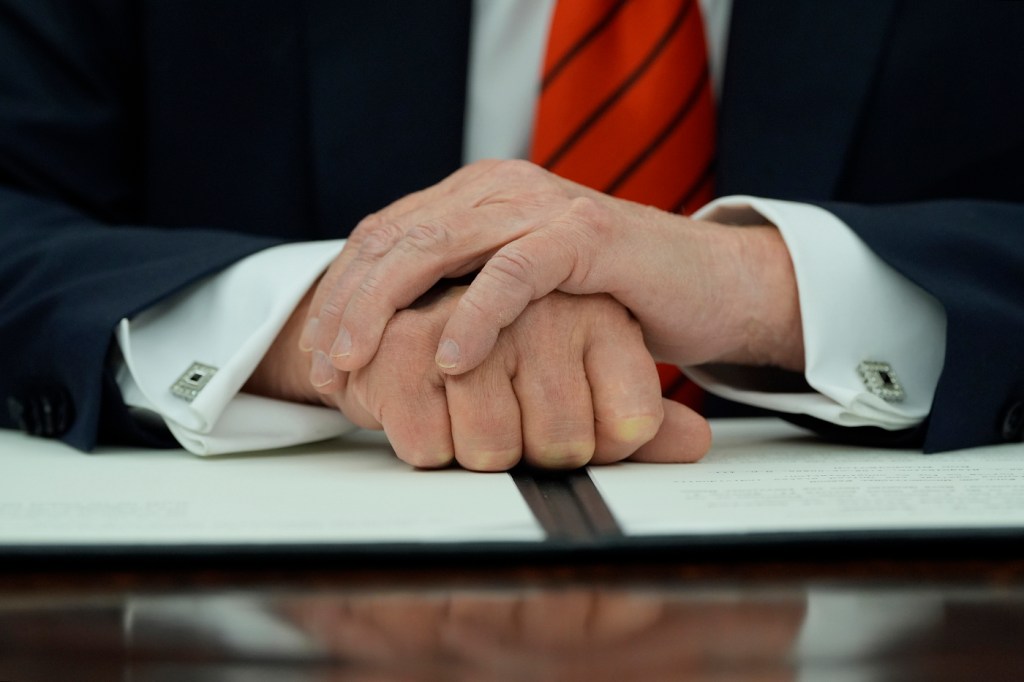Judges have issued preliminary injunctions against some of Donald Trump’s executive orders. What does that mean?
Northeastern University School of Law professor Jeremy Paul says the court pauses are designed to preserve the status quo while they review the claims.

During his first three weeks in office, President Donald Trump signed a flurry of executive orders that seek to reshape the federal bureaucracy. Many of those actions are now before judges, where they’re being reviewed.
Several judges have issued preliminary injunctions — or restraining orders — regarding Trump’s executive actions, pausing them from being implemented.
For example, a judge in New Hampshire blocked the administration from ending birthright citizenship by ordering an injunction, while a judge in Rhode Island halted the administration from freezing payments for grants and other programs by issuing a restraining order.
There are currently more than 40 lawsuits pending against the administration.
Northeastern University legal experts say the courts’ pauses are designed to preserve the status quo while the claims are reviewed.
Injunction vs. restraining order
As it pertains to these pauses, is the difference between an injunction and a restraining order?
Dan Urman, director of the law and public policy minor at Northeastern, who teaches courses on the Supreme Court, says an injunction requires a hearing or a court proceeding, while a restraining order — viewed as a “less drastic” intervention — typically does not.

Unlike a restraining order, which is usually temporary, an injunction can go on for much longer periods of time — some indefinitely, Urman says.
“The main difference is timing,” he says.
Lengthy legal battle ahead
But the temporary standoff is just the beginning of what could be a lengthy legal battle between the administration and its critics, says Northeastern University School of Law professor Jeremy Paul.
That’s because there are several laws that the administration’s orders could be violating, he says. There are civil service laws, for example, that protect certain government employees from being dismissed without just cause.
As it pertains to Trump’s funding freeze and spending cuts, Paul says the Constitution vests Congress with the power of the purse, meaning that federal money can’t simply be frozen or diverted without congressional authorization.
Editor’s Picks
Recourse for the administration
Paul predicts that the Trump administration will “at the very least” appeal the decisions, initiating a legal fight that may ultimately end up before the Supreme Court.
“It’s completely legitimate for the president to argue that, number one, he doesn’t agree with the interpretations of the statues,” Paul says. “He can argue that he thinks he is allowed to do these things. That’s a legitimate argument, and he can go to court and make that argument.”
Paul continues: “The second thing he can argue is that these laws restricting him from exercising his authority are unconstitutional. That, in fact, his view of the executive is that he’s not allowed to be restricted in this way — and some of those arguments are going to make it to the Supreme Court.”
Can a president ignore a court order?
What presidents can’t do, Paul says, is outright disregard a court decision. That would assume the president is the “adjudicator of what his own power is,” which runs contrary to the principles and structure of the U.S. government, he says.
The separation of powers doctrine, while not explicitly mentioned in the U.S. Constitution, states that there be three separate and independent branches of government, each with an ability to check and balance the other. While many responsibilities of the federal government overlap, the courts have traditionally clarified the limits and legitimacy of executive power, Paul says.
The Take Care Clause
Paul says that the legal challenges raised to Trump’s executive actions seek to ensure that the president performs his “constitutional obligation” to “take care that the laws be faithfully executed.” This duty, known as the Take Care Clause, is a provision in Article II of the Constitution — the most descriptive account of executive power in the founding document.
“He is trying to effectuate his policies, but he has to do so in a way that is consistent with the law,” Paul says.
“He is supposed to execute the laws that Congress passes, and it’s not up to him [Trump] to decide whether he’s doing that,” Paul continues. “It’s up to the courts to decide that.”
Urman says that if Trump were to ignore court edicts, it would “provoke a real constitutional crisis,” namely “confusion about which branch is responsible for addressing a public policy issue.”
“Presidents — and all other government officials — are required to abide by court rulings, even if they disagree with the decision,” Urman says.
“Truman followed the steel seizure case ruling in 1952, Nixon regarding turning over his private tapes in 1974, and Al Gore accepting the Supreme Court ruling that the Florida recount had to stop in 2000,” Urman adds.











